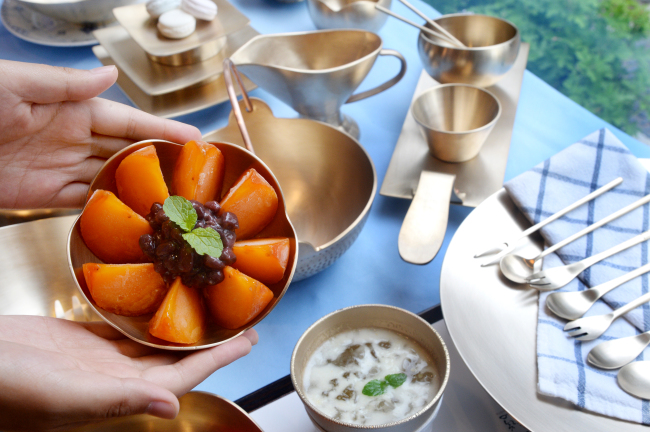Topping off a savory meal with something sweet has become a commonplace ritual all over the world.
But long before cafes or bakeries flooded the streets of Korea, sweets were not used as desserts but rather spotlighted on their own, according to Lee Sun-mi, professor of Korean traditional cuisine at Sookmyung Women’s University’s Korean Food Institute.

A plate of ripe persimmon and red bean paste (left) and iced yuja tea at Cafe Noshi (Park Hyun-koo/The Korea Herald)
“Korean confectionaries, or hangwa, were meant for special occasions such as feasts, or presented as in-between-meal snacks for royals,” Lee said. “They had their own little table in front of the king.”
Various types of hangwa exist, usually made from rice or glutinous rice, combined with spices such as cinnamon and ginger and sweetened with fruits and jocheong, a type of fermented gluten.
They come in a number of dainty shapes and sizes: yugwa, light and fluffy fried wheat covered in popped rice, are shaped like fingers; gangjeong are grains compacted together with rice wine, honey and water to form small, sweet bricks.
Sinfully extravagant While hangwa were enjoyed by royals and noblemen since as early as 300 AD, there were times when the sweet confectionaries were deemed too luxurious -- and banned from being cooked altogether in times of poor harvest, records say.
Leftover rice was the underlying source of many of the ingredients used to create traditional desserts.
The sweet, taffy-like yeot, for example, was made by fermenting and continually boiling steamed rice in a large pot. The honey-like jocheong, boiled for a shorter amount of time, was used to add sweetness. Typically, 4 kilograms of rice is needed for 1 kilogram of jocheong, which is why only the wealthy could afford the sweet pleasures.
During the reign of Goryeo’s 19th king Myeongjong, for example, the creation of all yumilgwa was banned by law in 1192, according to Kim Kyu-heun, a master of Korean hangwa.
At the time, yumilgwa was considered a type of particularly extravagant hangwa made with wheat flour dough, and lots of oil for their characteristic smooth and creamy texture. They were usually shaped to resemble flowers and fruit.
“The ingredients for yumilgwa -- grain, honey and oil -- were seen as too precious, and their overuse was considered harmful to the people,” he said.
Restored to former glory Eateries have recently taken to restoring Korean desserts to their former glory.
Cafe Noshi in Jongno-gu serves Korean desserts such as yuja tea, mixed-grain latte and ripe persimmon with sweet red-bean paste all in luxurious brassware.
“Brassware was originally used by kings to prevent being poisoned,” said Chung Jae-mi, manager at the cafe. Brassware dishes change color when they come into contact with poison.
“Brassware was primarily used for rice and side-dishes, but rarely for snacks and desserts,” said Chung. “We wanted to highlight the uniqueness of Korean desserts by placing them in these bowls,” she explained.
Gotgan by Lee Jong-guk, a Korean fine-dining restaurant opened by the Korean chef and food researcher Lee Jong-guk, pays meticulous attention to its dessert course.
The course consists of a selection of hard-to-come-by Korean desserts such as apple danja, a type of tiny rice cake in the shape of an apple, dried fruit, and millet pancake, a type of pancake filled with red bean paste.
At Kaydee, located in Gangnam-gu, hangwa is paired with different types of wine to maximize the sweetness of the dessert and fruitiness of the drink.
Wines such as the slightly acidic Moscato d’Asti are paired with carrot hangwa. Pine nut gangjeong accompany the Piemonte sparkling wine.
By Rumy Doo (
doo@heraldcorp.com)




![[From the Scene] Monks, Buddhists hail return of remains of Buddhas](http://res.heraldm.com/phpwas/restmb_idxmake.php?idx=645&simg=/content/image/2024/04/19/20240419050617_0.jpg&u=20240419175937)

